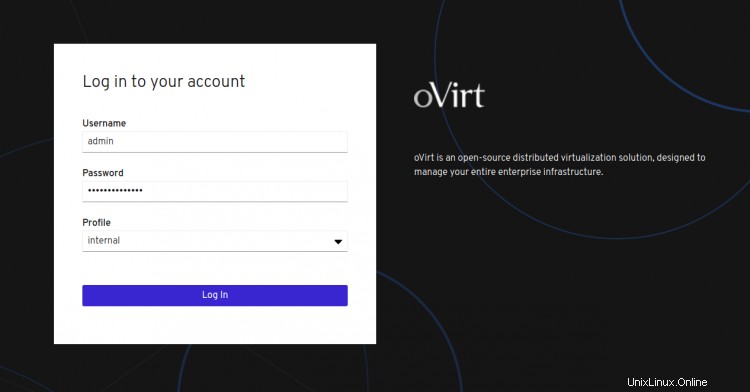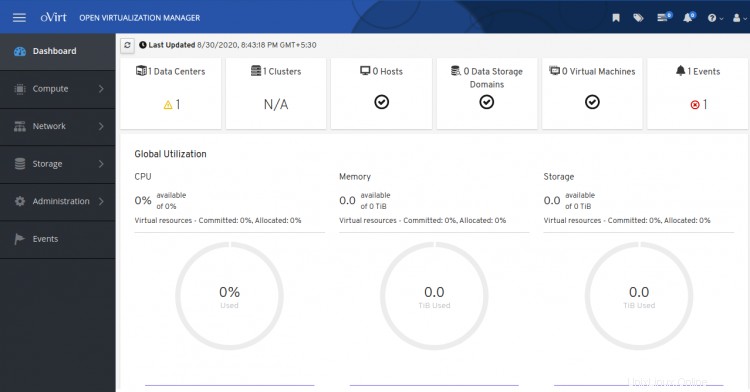oVirtは、インフラストラクチャ全体の管理に使用できる無料のオープンソース分散仮想化ソリューションです。これはRedHatEnterprise Virtualizationに基づいており、Webベースのインターフェースから仮想マシン、コンピューティング、ストレージ、およびネットワークリソースを管理できます。 KVMハイパーバイザーを使用し、libvirt、Gluster、PatternFly、Ansibleなどの他のいくつかのコミュニティプロジェクトに基づいて構築されています。
このチュートリアルでは、CentOS8サーバーにoVirtをインストールする方法を説明します。
- 16GB以上のRAMを搭載したCentOS8を実行しているサーバー。
- ルートパスワードがサーバーに設定されます。
開始する前に、システムにFQDNホスト名を設定する必要があります。次のコマンドで実行できます:
hostnamectl set-hostname centos.example.com
次に、/ etc / hostsファイルを編集し、システムIPをホスト名にバインドする必要があります。
nano /etc/hosts
次の行を追加します:
your-server-ip centos.example.com
終了したら、ファイルを保存して閉じます。
次に、システムにoVirtとその他の必要なリポジトリを追加する必要があります。
まず、次のコマンドを使用してoVirtリポジトリをインストールします。
dnf install https://resources.ovirt.org/pub/yum-repo/ovirt-release44.rpm
インストールしたら、次のコマンドを使用してJavaパッケージツール、pki-deps、およびPostgreSQLモジュールを有効にします。
dnf module enable javapackages-tools -y
dnf module enable pki-deps -y
dnf module enable postgresql:12 -y
終了したら、次のステップに進むことができます。
oVirtエンジンのインストールとセットアップ
まず、次のコマンドを使用してリポジトリを更新します。
dnf update -y
リポジトリが更新されたら、次のコマンドを使用してoVirtEngineをインストールします。
dnf install ovirt-engine -y
インストールが完了したら、次のコマンドを使用してoVirtエンジンを構成できます。
engine-setup
以下に示すように、セットアップ中にいくつかの質問があります。
--== PRODUCT OPTIONS ==--
Configure Cinderlib integration (Currently in tech preview) (Yes, No) [No]: Yes
Configure Engine on this host (Yes, No) [Yes]: Yes
Configuring ovirt-provider-ovn also sets the Default cluster.'s default network provider to ovirt-provider-ovn.
Non-Default clusters may be configured with an OVN after installation.
Configure ovirt-provider-ovn (Yes, No) [Yes]: Yes
Configure WebSocket Proxy on this host (Yes, No) [Yes]: Yes
* Please note * : Data Warehouse is required for the engine.
If you choose to not configure it on this host, you have to configure
it on a remote host, and then configure the engine on this host so
that it can access the database of the remote Data Warehouse host.
Configure Data Warehouse on this host (Yes, No) [Yes]: Yes
Configure Grafana on this host (Yes, No) [Yes]: Yes
Configure VM Console Proxy on this host (Yes, No) [Yes]: Yes
--== PACKAGES ==--
[ INFO ] Checking for product updates...
[ INFO ] No product updates found
--== NETWORK CONFIGURATION ==--
Host fully qualified DNS name of this server [centos.example.com]: Yes
[WARNING] Host name Yes has no domain suffix
[ ERROR ] Host name is not valid: Yes did not resolve into an IP address
Host fully qualified DNS name of this server [centos.example.com]:
[WARNING] Failed to resolve centos.example.com using DNS, it can be resolved only locally
Setup can automatically configure the firewall on this system.
Note: automatic configuration of the firewall may overwrite current settings.
Do you want Setup to configure the firewall? (Yes, No) [Yes]: Yes
--== DATABASE CONFIGURATION ==--
Where is the DWH database located? (Local, Remote) [Local]: Local
Setup can configure the local postgresql server automatically for the DWH to run. This may conflict with existing applications.
Would you like Setup to automatically configure postgresql and create DWH database, or prefer to perform that manually? (Automatic, Manual) [Automatic]:
Where is the ovirt cinderlib database located? (Local, Remote) [Local]:
Setup can configure the local postgresql server automatically for the CinderLib to run. This may conflict with existing applications.
Would you like Setup to automatically configure postgresql and create CinderLib database, or prefer to perform that manually? (Automatic, Manual) [Automatic]:
Where is the Engine database located? (Local, Remote) [Local]:
Setup can configure the local postgresql server automatically for the engine to run. This may conflict with existing applications.
Would you like Setup to automatically configure postgresql and create Engine database, or prefer to perform that manually? (Automatic, Manual) [Automatic]:
--== OVIRT ENGINE CONFIGURATION ==--
Engine admin password:
--== SUMMARY ==--
[ INFO ] Restarting httpd
Please use the user '[email protected]' and password specified in order to login
Web access is enabled at:
http://centos.example.com:80/ovirt-engine
https://centos.example.com:443/ovirt-engine
Internal CA 65:FA:CD:BF:DD:2D:F4:99:D6:63:85:80:97:B9:66:B9:C7:29:5A:F3
SSH fingerprint: SHA256:Y46liXyme5Fz/oJA9QaYY1dhK8BKeJiw1kcSjOYL204
[WARNING] Less than 16384MB of memory is available
Web access for grafana is enabled at:
https://centos.example.com/ovirt-engine-grafana/
Please run the following command on the engine machine centos.example.com, for SSO to work:
systemctl restart ovirt-engine
--== END OF SUMMARY ==--
[ INFO ] Stage: Clean up
Log file is located at /var/log/ovirt-engine/setup/ovirt-engine-setup-20200830105920-2u1ydn.log
[ INFO ] Generating answer file '/var/lib/ovirt-engine/setup/answers/20200830110513-setup.conf'
[ INFO ] Stage: Pre-termination
[ INFO ] Stage: Termination
[ INFO ] Execution of setup completed successfully
インストールが正常に完了すると、上記の出力にoVirt管理コンソールとGrafanaダッシュボードのURLが表示されます。
デフォルトでは、SELinuxはCentOS 8で有効になっているため、oVirt用にSELinuxを構成する必要があります。次のコマンドで構成できます:
setsebool -P httpd_can_network_connect 1
次に、firewalldを介してポート80と443を許可する必要があります。次のコマンドで実行できます:
firewall-cmd --permanent --zone public --add-port 80/tcp
firewall-cmd --permanent --zone public --add-port 443/tcp
firewall-cmd --reload
終了したら、次のステップに進むことができます。
oVirt管理コンソールにアクセス
次に、Webブラウザーを開き、URLhttps://centos.example.com/ovirt-engine/sso/login.htmlを入力します。 oVirtログインページが表示されます:

adminとしてのユーザー名と、インストール中に設定したパスワードを入力し、ログをクリックします。 で ボタン。次の画面が表示されます。

次に、管理をクリックします ポータル 。次の画面にoVirtダッシュボードが表示されます。

おめでとう! CentOS8サーバーにoVirtEngineが正常にインストールされました。これで、oVirtコンソールからリモート仮想化ホストを追加し、oVirtダッシュボードから最初の仮想マシンの作成を開始できます。ご不明な点がございましたら、お気軽にお問い合わせください。